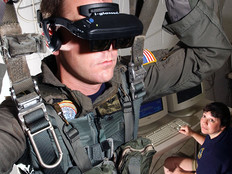DOD, DHS and NASA Are Driving Adoption of Internet of Things Sensors
The Department of Defense, Department of Homeland Security and NASA are the agencies that are spurring spending on, and adoption of, Internet of Things sensors across the federal government, according to a recent report from Big Data and analytics firm Govini. In the years ahead, civilian agencies will likely deploy such sensors in greater numbers, but various partnerships will be needed to migrate defense-related technologies to those agencies, Govini says.
According to Govini, the federal IoT market saw 20 percent year-over-year growth in fiscal year 2015, a trend that will likely to continue as DOD applications increase to support the Pentagon’s innovation strategy.
Govini breaks down the IoT into two main categories: infrastructure, which involves equipment to enable the exchange of information between sensors, the cloud and devices; and software, which refers to applications that facilitate the transmission, storage and analytics of sensor-collected data. Cybersecurity is key for wireless devices, cloud storage and IoT sensors, as well as software elements like data processing and device-based apps.
A Growing Sensor Market
The federal IoT market is experiencing steady growth despite a slight dip in fiscal 2013 due to sequestration, as spending increased by 20 percent to $8.8 billion in fiscal 2015, up from $7.4 billion in fiscal 2014, according to Govini.
In fiscal 2015, sensors saw the greatest increase, at 56 percent; followed by cloud storage with a 48 percent spending increase; and then Extract, Transform and Load & Data processing, which saw a 46 percent increase. Growth in sensors is being driven by DOD-relayed technologies as well as NASA research and development efforts in partnership with universities.
While sensors represented just under 10 percent of the federal IoT market in fiscal 2011, sensors made up almost 18 percent in fiscal 2015, Govini reports, thanks largely to mission-critical DOD requirements for surveillance, and situational awareness to protect the soldiers. Sensor spending almost tripled in that time frame, rising from $578 million in fiscal 2011 to $1.6 billion in fiscal 2015.
What’s driving that growth? Over the past four years, defense-related agencies accounted for the vast majority of sensor spending, at 88 percent. The Army has been the top buyer of non-weapons platform sensors, driving much of early sensor investment, and accounted for 37 percent of spending between fiscal 2011 and fiscal 2015.
The Army has used sensors to support ground operations in Iraq and Afghanistan by providing secure communications and threat detection; it also has invested in hand-held mobile sensors and integrated communication equipment, according to Givini. The report notes that the Army is currently investing in the development of biosensors and wearables to protect the warfighter. Another application is using sensors on blimps over supply lanes and ground sensors to create situation awareness on the ground for soldiers.
The Air Force has been the second largest sensor buyer between fiscal years 2013 and 2015, in large part by adding sensors on munitions for guidance and onto platforms for intelligence, surveillance and reconnaissance capabilities.
NASA and DHS are the leading civilian agencies adopting sensor technology, with DHS spending $231 million between fiscal 2011 and fiscal 2015, followed by NASA at $28 million.
“Given the similarity of the two agencies’ missions to Defense agencies, little additional technology development was required for initial sensor adoption,” the report notes. “NASA use to observe earth and space patterns, communications, and space transmissions is similar to Air Force applications, while DHS Customs and Border Protection use of sensors for surveillance replicates defense usage.”
Where is the Federal IoT Sensor Market Going?
Govini says sensor development is the “lynchpin” of IoT, and that such development will determine how federal agencies adopt the IoT, especially pioneering DOD technology that gets adapted for use in civilian agencies.
The transition to create civilian applications based around sensors will require partnership between aerospace and defense firms and IT companies, along with academia, to bridge the capabilities gap created by different IoT uses and demands, Govini says.
“Continued R&D is critical to adapt defense technology to penetrate civilian agencies, creating opportunity for sensor applications to evolve to support prominent missions like health IT” at the Department of Veterans Affairs and the Department of Health and Human Services, Govini notes.
Govini also adds that “the future of IoT represents the convergence of mission and enterprise. Industry must work with academia to bring these two disparate pieces together.”




.png)



